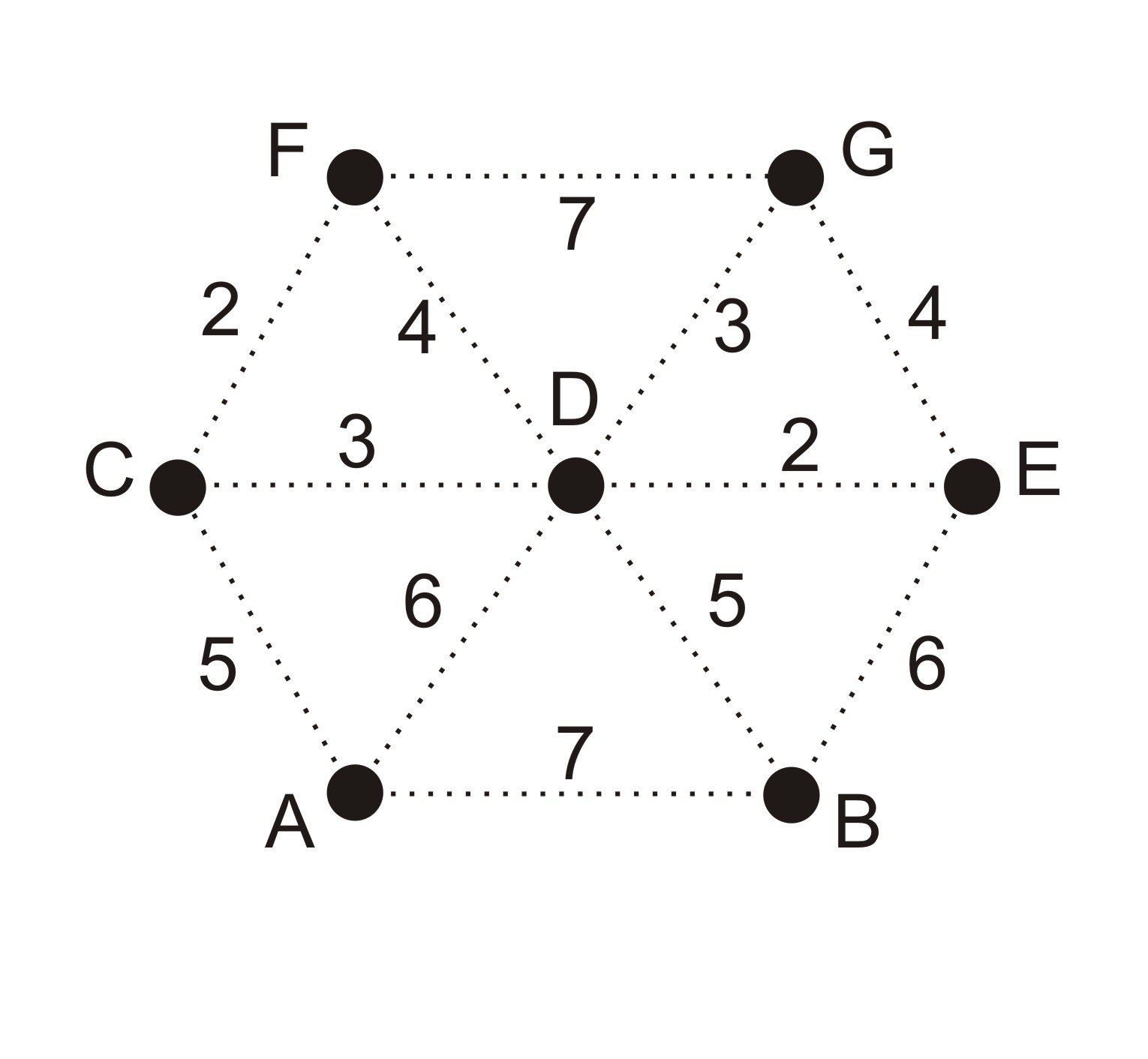Kruskal's algorithm
2. Proposals of adaptation
1. Edges of a graph are organized in a table according to nodes, and a subgraph is created in another document (sheet):
The graph is converted to a table. We add labels of the nodes to the first column.
All the other cells on the row for a node  are reserved for the edges coming out from
are reserved for the edges coming out from  and are written as
and are written as  –
– –
– where
where  is a weight of the edge and
is a weight of the edge and  is
the end node of the edge. We use another sheet or a separate text file:
is
the end node of the edge. We use another sheet or a separate text file:
- to add the edges of the subgraph
 consecutively.
consecutively. - to organize sets of nodes connected together by existing
edges of the subgraph
 .
.
Let's take the same graph  with seven nodes illustrated in Image 2.
The following two tables (see Table 1 and Table 2)
demonstrate the situation after addition of the first two edges to the subgraph
with seven nodes illustrated in Image 2.
The following two tables (see Table 1 and Table 2)
demonstrate the situation after addition of the first two edges to the subgraph  .
.
Example 2:
Graph  from Image 1
converted to a table
from Image 1
converted to a table
Example 3:
Subgraph  (the future minimum spanning tree)
(the future minimum spanning tree)
The last table demonstrates the following fact.
The first two edges of the subgraph  connect two sets of
nodes
connect two sets of
nodes  and
and  .
Before adding the next edge
.
Before adding the next edge  –
– –
– we have to check if it does not imply a new cycle at the subgraph
we have to check if it does not imply a new cycle at the subgraph  .
A sighted student checks that visually while a blind one does so by organizing sets
of nodes connected together by edges of the subgraph
.
A sighted student checks that visually while a blind one does so by organizing sets
of nodes connected together by edges of the subgraph  .
If both nodes of a processed edge belong to the same set of nodes,
he/she immediately knows a cycle is going to be created.
Otherwise he/she can update the Table 3,
add the processed edge to the subgraph
.
If both nodes of a processed edge belong to the same set of nodes,
he/she immediately knows a cycle is going to be created.
Otherwise he/she can update the Table 3,
add the processed edge to the subgraph  and modify the sets of nodes connected together. He/she should not forget the
currently processed edge was kept in the Table 2
twice therefore it is necessary to delete it at both places.
and modify the sets of nodes connected together. He/she should not forget the
currently processed edge was kept in the Table 2
twice therefore it is necessary to delete it at both places.
2. Edges are organized in two rows of a table, a subgraph is created in another document (sheet):
The graph is again converted to a table but edges are organized differently.
They are completely described in the first column as
strings  –
– –
– where symbols
where symbols  indicate nodes connected by an edge with a weight
indicate nodes connected by an edge with a weight  .
The second column serves to repeat the weight of the edge. Such an organization of the edges is demonstrated
in Table 3.
.
The second column serves to repeat the weight of the edge. Such an organization of the edges is demonstrated
in Table 3.
Example 4: Graph edges organized in two columns
Most of the spreadsheet applications enable users to arrange data according
to values of a certain column. Therefore a blind student can
sort edges in ascending order with regard to weights kept in the second column.
To consecutively prepare the subgraph  and sets of nodes connected by the subgraph's edges we use the second sheet or
a separate document. We process the algorithm in the same manner as previously.
and sets of nodes connected by the subgraph's edges we use the second sheet or
a separate document. We process the algorithm in the same manner as previously.

 where
where  is a set of
nodes,
is a set of
nodes,  is a set of undirected edges and
is a set of undirected edges and  is
a positive weight of any edge.
is
a positive weight of any edge.
 containing all the nodes of the graph
containing all the nodes of the graph  and an empty set of edges
and an empty set of edges
 ,
,  ,
,
 were added to the subgraph
were added to the subgraph  does not establish a cycle and therefore we can add it to the
subgraph
does not establish a cycle and therefore we can add it to the
subgraph 
 to the subgraph
to the subgraph  or
or  ).
).

 ,
,  ,
,  ,
,  –
– –
– –
– –
–

 –",
"–
–",
"–